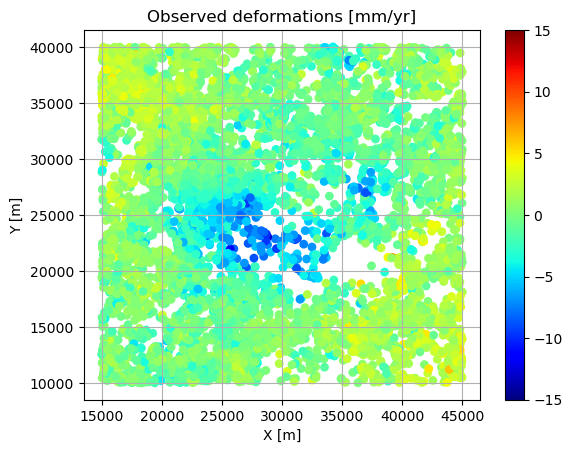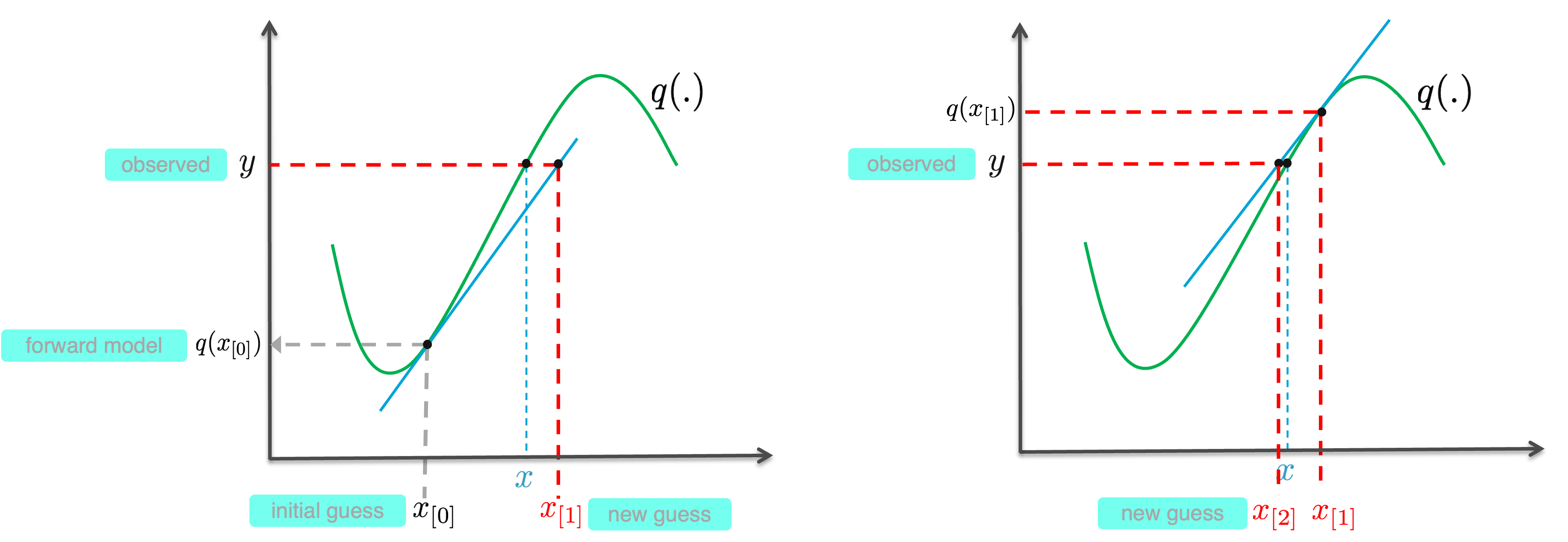6.7. Non-linear least-squares estimation#
Let the non-linear system of observation equations be given by:
This system cannot be directly solved using the weighted least-squares or the best linear unbiased estimators. Here, we will introduce the non-linear least-squares principle, based on a linearization of the system of equations.
One example of a non-linear problem is the positioning model.
Observable \(Y_i\) is deformation rate at known location \((x_i,y_i)\) due to an unknown volume change \(\Delta V\) of a magma chamber at unknown depth \(d\). The observation equation according to the so-called Mogi model would be:
where \((x_s,y_s)\) are the unknown horizontal coordinates of the centre of the magma chamber. This observation equation is non-linear in three out of the four unknowns.
Fig. 6.10 shows a spatial dataset with 10,000 observed deformation rates above a magma chamber. Hence we have a system of 10,000 non-linear observation equations in four unknowns. How to solve it?

Fig. 6.10 Observed deformation rates above a magma chamber.#
Video#
Linearization#
For the linearization we need the first-order Taylor polynomial, which gives the linear approximation of for instance the first observable \(Y_1 = q_1(\mathrm{x})\) at \(\mathrm{x}=\mathrm{x}_{[0]}\) as:
where \(\Delta \mathrm{x}_{[0]} = \mathrm{x}- \mathrm{x}_{[0]}\) and \(\mathrm{x}_{[0]}\) is the initial guess of \(\mathrm{x}\). Note that for now we ignore the random errors in the equations.
Let us now consider the difference between the observable \(Y_1\) and the solution of the forward model at \(\mathrm{x}_{[0]}\):
which we refer to as the observed-minus-computed observable. Note that \(\Delta \mathrm{x}_{[0]}\) is an \(n\times 1\) vector.
We can now obtain the linearized functional model:
with Jacobian matrix \(\mathrm{J}_{[0]}\).
And this allows to apply best linear unbiased estimation (BLUE) to get an estimator for \(\Delta \mathrm{x}_{[0]}\):
since the Jacobian \( \mathrm{J}_{[0]}\) takes the role of the design matrix \(\mathrm{A}\) and the observation vector is replaced by its \(\Delta\)-version as compared to the BLUE of the linear model \(\mathbb{E}(Y) = \mathrm{Ax}\).
Since we have \(\Delta \mathrm{x}_{[0]} = \mathrm{x}- \mathrm{x}_{[0]}\), an “estimator” of \(\mathrm{x}\) can thus be obtained as:
However, the quality of the linear approximation depends very much on the closeness of \(\mathrm{x}_{[0]}\) to \(\mathrm{x}\). Therefore, instead we apply an iterative procedure, which means that we repeat the process with \(\mathrm{x}_{[1]}=\mathrm{x}_{[0]}+\Delta \hat{X}_{[0]}\) as our new guess. This procedure is continued until the \(\Delta \hat{\mathrm{x}}_{[i]}\) becomes small enough. This is called the Gauss-Newton iteration procedure, and is shown in the scheme below.
Gauss-Newton iteration#
See Fig. 6.11 for an illustration of the iterative procedure, referred to as the Gauss-Newton iteration.

Fig. 6.11 Visualization of two iteration steps of Gauss-Newton iteration. The non-linear function \(q\) is shown, together with the linear approximations (blue line) at \(q(x_{[i]})\) in each step.#
Assume we have the observation vector \(\mathrm{y}\) (realization of \(Y\)).
Start with initial guess \(\mathrm{x}_{[0]}\), and start iteration with \(i=0\)
Calculate observed-minus-computed \(\Delta \mathrm{y}_{[i]} = \mathrm{y} - q(\mathrm{x}_{[i]}) \)
Determine the Jacobian \(\mathrm{J}_{[i]}\)
Estimate \(\Delta \hat{\mathrm{x}}_{[i]}=\left(\mathrm{J}_{[i]}^T \Sigma_{Y}^{-1} \mathrm{J}_{[i]} \right)^{-1}\mathrm{J}_{[i]}^T \Sigma_{Y}^{-1}\Delta \mathrm{y}_{[i]}\)
New guess \(\mathrm{x}_{[i+1]}=\Delta\hat{\mathrm{x}}_{[i]}+ \mathrm{x}_{[i]}\)
If stop criterion is met: set \(\hat{\mathrm{x}}=\mathrm{x}_{[i+1]}\) and break, otherwise set \(i:=i+1\) and go to step 1
In this scheme we need to choose a stop criterion, for which we use:
The normal matrix \(\mathrm{N}_{[i]}\) is used as a weight matrix, since it is equal to the inverse of the covariance matrix of the estimated \(\Delta \hat{\mathrm{x}}_{[i]}\), and estimated parameters with small variance should have a relatively small deviation compared to parameters with large variance.
The threshold \(\delta\) must be set to a very small value, e.g., \(10^{-8}\).
Once the stop criterion is met, we say that the solution converged, and the last solution \( \mathrm{x}_{[i+1]}\) is then finally used as our estimate of \(\mathrm{x}\).
Remarks and properties#
There is no default recipe for making the initial guess \(\mathrm{x}_{[0]}\); it must be made based on insight into the problem at hand. A good initial guess is important for two reasons:
a bad initial guess may result in the solution NOT to converge;
a good initial guess will speed up the convergence, i.e. requiring fewer iterations.
The covariance matrix of \(\hat{X}\) is given by:
although this is not strictly true. The estimator \(\hat X\) is namely NOT a best linear unbiased estimator of \(\mathrm{x}\) since we used a linear approximation. And since the estimator is not a linear estimator due to ignoring the higher-order terms, it is not normally distributed.
However, in practice the linear (first-order Taylor) approximation often works so well that the performance is very close to that of BLUE and we may assume the normal distribution.
As a final note we would like to mention that the Gauss-Newton method is just one approach for solving a non-linear least-squares problem. In practice, especially for highly non-linear problems, the Levenberg-Marquardt method is often used. It can be considered as a refinement of the Gauss-Newton method with a higher chance of convergence.
Attribution
This chapter was written by Sandra Verhagen. Find out more here.
